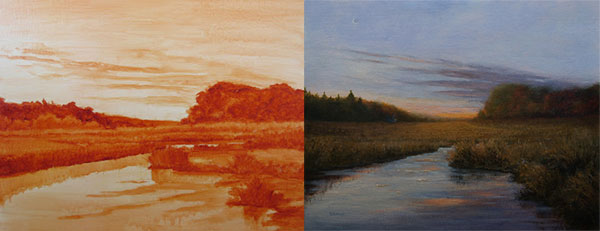Warm Underpainting:
Paint underneath the painting with a wash of a warm color….
It forces you to cover the background with opaques, forcing you to make mixing decisions.
Most helpful for blue/green paintings–the warm bits peeking through make the greens/blues sparkle.

Sky Panels:
Sky panel is a surface prepared with a sky gradation as a base layer for future painting. (Basically, you paint the sky first, and then come back later to paint everything else once the sky is dried.)
Helpful for describing intricate details against a light sky, and when your chief interest is the complex, middle-ground tracery.
You can prepare backgrounds in advance because clear skies are fairly standard and predictable.
Limited Palettes
Go on a color diet! It leads to a more harmonious effect.

This painting was made with only titanium white, pyrrole red, ultramarine blue, and burnt sienna.
3 reasons to do this:
more harmonious, it forces you out of color-mixing habits, and they’re compact and portable.
Make color wheel tests to preview the range of possibilities with a limited palette. Try using one full-chroma color with two weaker colors from across the center of the spectrum.
The Mud Debate
“Beware of Mud”
Some only use primary pigments laid over each other to transparently achieve all other colors. “Overmixing makes color muddy sometimes, especially when more than three colors are used.”
“Mud is a Myth”
Others say there’s no such thing as a muddy color mixture. Either you’ve mixed the right color or you haven’t. The dullness/muddiness comes from poor value organization. It doesn’t matter how you come to achieve a mixture.
Gurney’s opinion: more paintings suffer from the “fruit salad disease” of too much pure color rather than from murky mud. The cure for either problem is good value organization–good planning.